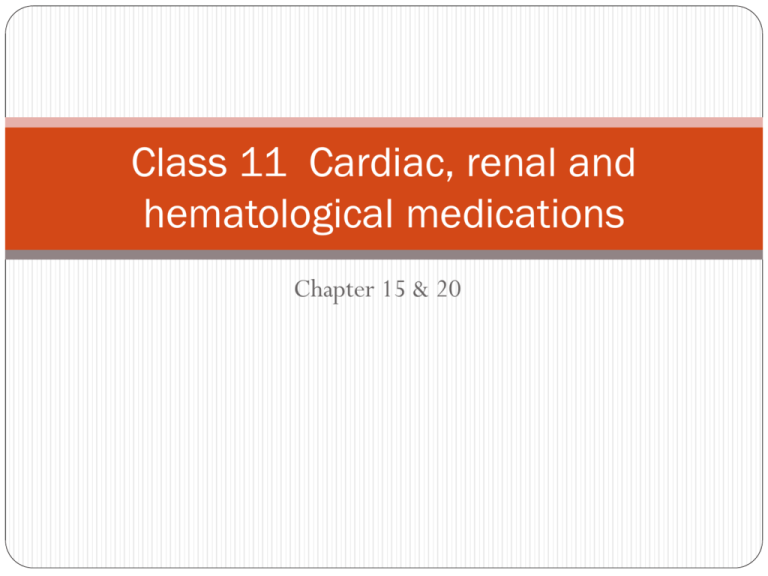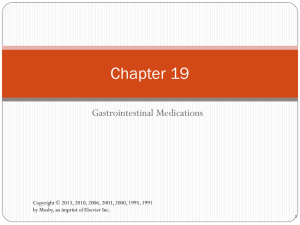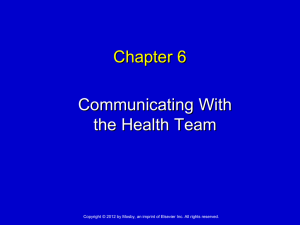Class 11 Cardiac, renal and hematological medications
advertisement

Class 11 Cardiac, renal and hematological medications Chapter 15 & 20 Learning Objectives Identify the approved way to give different forms of antianginal therapy Discuss the uses and general actions of cardiac drugs used to treat dysrhythmias Describe the common treatment for various types of lipoprotein disorders 2 Copyright © 2013, 2010, 2006, 2003, 2000, 1995, 1991 by Mosby, an imprint of Elsevier Inc. Antianginals and Peripheral Vasodilators Antianginals Nitrates: “Universal Vasodilators” Directly cause vascular smooth muscle to relax in arterial and venous circulation Decrease myocardial oxygen use Increase collateral-vessel circulation to the heart Calcium Channel Blockers Dilate coronary arteries and arterioles Reduce response of electrical conduction system 3 Copyright © 2013, 2010, 2006, 2003, 2000, 1995, 1991 by Mosby, an imprint of Elsevier Inc. Antianginals and Peripheral Vasodilators (cont.) Adverse Reactions Nitrates: Flushing, postural hypotension, tachycardia, confusion, dizziness, fainting, headache, lightheadedness, vertigo, weakness, drug rash, localized pruritus, skin lesions, eye and mouth edema, local burning in mouth, nausea and vomiting Peripheral Vasodilators: Headache, weakness, tachycardia, flushing, postural hypotension, dysrhythmias, confusion, severe rash, nervousness, tingling, and sweating 4 Copyright © 2013, 2010, 2006, 2003, 2000, 1995, 1991 by Mosby, an imprint of Elsevier Inc. Nitrate Products Any drug with NITR- in the generic with cause vasodilation Nitroglycerin** isosorbide dinitrate isosorbide mononitrate These are the main drugs in this category. Nitroglycerin (NTG) can be given in multiple forms: PO pills & spray; sublingual; IV medication; ointment; & slow release topical patches. 5 Copyright © 2013, 2010, 2006, 2003, 2000, 1995, 1991 by Mosby, an imprint of Elsevier Inc. Peripheral vasodilator Apresoline (hydralazine) Treatment of hypertension and high afterload heart failure Causes blood dyscrasias so monitor the CBCs Question 2 Which are the best drugs for treating coronary artery disease? 1. 2. 3. 4. 7 Beta blockers Calcium channel blockers Diuretics Nitrates Copyright © 2013, 2010, 2006, 2003, 2000, 1995, 1991 by Mosby, an imprint of Elsevier Inc. Antidysrhythmics Four Classes Class I: disopyramide, procainamide, quinidine Lengthen the refractory period Decrease cardiac excitability Class II: acebutolol, esmolol, propranolol Reduce sympathetic excitation (reduce loading) Class III: amiodarone Lengthen the time it takes for one cell to fire and recover Class IV: verapamil Blocks calcium entry into the myocardium, prolongs resting phase **A good reference for understanding classes. 8 Copyright © 2013, 2010, 2006, 2003, 2000, 1995, 1991 by Mosby, an imprint of Elsevier Inc. Antidysrhythmics CLASS 1 A CLASS 1B Norpace (V) Xylocaine (V) dysopyramide Pronestyl (V,A) Procainamide (V) = ventricular action (A) = atrial action lidocaine Antidysrhythmics Class 2 Beta blockers Class 3 Brevibloc (V) Cordarone / Pacerone (V) esmolol Inderal (V) propranolol Amiodarone 100 day half life !! Betapace (V) sotalol Antidysrhythmics Class 4 Calcium channel blocker Adenocard (V) Calan / Isoptin adenosine Verapamil Given rapid IV push & Can cause hypotension flush Causes SOB & dyspnea Facial flushing Can not have any grapefruit while on any calcium channel blockers Antidysrhythmics (cont.) Action and Uses Quinidine and Procainamide Treat rapid and irregular dysrhythmias by decreasing the excitability of myocardial cells Bretylium Slows conduction rate in the ventricles, slows norepinephrine release in the myocardium Disopyramide Slows the depolarization of cardiac cells 12 Copyright © 2013, 2010, 2006, 2003, 2000, 1995, 1991 by Mosby, an imprint of Elsevier Inc. Antidysrhythmics (cont.) Lidocaine Increases the strength of electrical impulses Adenosine Stops the heart for several seconds to allow it to convert to normal sinus rhythm Beta-adrenergic blockers (propranolol) Decrease the heart’s beta-receptor response to epinephrine and norepinephrine 13 Copyright © 2013, 2010, 2006, 2003, 2000, 1995, 1991 by Mosby, an imprint of Elsevier Inc. Antihyperlipidemics Types of Lipoproteins Chylomicrons (mostly triglycerides) Formed from absorption of dietary fat in intestine Very low-density lipoproteins (VLDLs) Made up of large amounts of triglycerides that were made in the liver (pre-beta lipoproteins) Low-density lipoproteins (LDLs) Breakdown of VLDLs linked with cholesterol and protein High-density lipoproteins (HDLs) Clear out excess cholesterol from tissue 14 Copyright © 2013, 2010, 2006, 2003, 2000, 1995, 1991 by Mosby, an imprint of Elsevier Inc. Antihyperlipidemics Bile Acid Sequestrants HMG-COA reductase (chole or cole = bile) Questran inhibitors (-statins) Lipitor Cholestyramine resin Colestid colestipol WelChol colesevelam atorvostatin calcium Pravachol pravastatin Zocor simvastatin Antihyperlipidemics Miscellaneous Make sure you check what Tricor time of day the drugs must be given. Some are with food, others are before food. Some do not matter. fenofibrate Lopid genfribrozil Niaspan nicotinic acid or naicin Cardiotonics Actions Increase the contraction strength or force (positive inotropic action) Slow the heart rate Uses Treatment of CHF and rapid or irregular heartbeats (atrial fibrillation, atrial flutter, frequent PVCs or paroxysmal atrial tachycardia) 17 Copyright © 2013, 2010, 2006, 2003, 2000, 1995, 1991 by Mosby, an imprint of Elsevier Inc. Cardiotonics (cont.) Adverse Reactions Digitalis toxicity: serum digoxin levels verify The amount of medication that is helpful (therapeutic) and the amount that is harmful (toxic) are not very different. This is called a narrow therapeutic window. Don’t confuse the sound-alikes digoxin and digitoxin Drug Interactions Nursing Implications and Patient Teaching Copyright © 2013, 2010, 2006, 2003, 2000, 1995, 1991 by Mosby, an imprint of Elsevier Inc. 18 Cardiotonics Lanoxin / Digitek Digoxin Primacor milrinone dobutamine 19 Copyright © 2013, 2010, 2006, 2003, 2000, 1995, 1991 by Mosby, an imprint of Elsevier Inc. Mrs. Moskaluk’s HTN Guide A = ACE inhibitors (vasodilation and decrease plasma volume) and ARBs for vasodilation (-pril & - sartan drugs) B = Beta blockers – lowers heart rate and vasodilates (-lol) C = Calcium channel blockers (-dipine drugs) D = Diuretics (-thiazide and loop are K+ losers; aldactone is K+ sparing) E = Exercise to clean the vessels ‘F’ diet = fish, fluid, fiber, and fruit -zosin drugs are alpha 1 adrenergic blockers 20 Copyright © 2013, 2010, 2006, 2003, 2000, 1995, 1991 by Mosby, an imprint of Elsevier Inc. Urinary incontinence drugs Antispasmotics/ BPH meds anticholinergics Ditropan (p in the pan) Proscar (think prostate) oxybutynin Pro-Banthine propantheline finasteride Flomax Tamulosin ‘maximize the flow’ Detrol Tolterodine ‘Gotta go right now’ TV commercial • Urinary Tract Analgesic • Pyridium • phenazopyridine Hematologic Products Chapter 20 7th ed. Learning Objectives Describe the influence of anticoagulants on blood clotting Identify drugs that act in the formation, repair, or function of red blood cells Identify at least three adverse reactions associated with hematologic products. Copyright © 2013, 2010, 2006, 2003, 2000, 1995, 1991 by Mosby, an imprint of Elsevier Inc. 23 Anticoagulants Two Categories • Coumarin and indandione derivatives • Limit the formation of blood coagulation factors II, VII, IX, and X in the liver by interfering with vitamin K • Antidote: Vitamin K injection/ infusion • Heparin sodium • Increases the action of antithrombin III (heparin cofactor) on several other coagulation factors to slow new clot development • Antidote: Protamine sulfate Copyright © 2013, 2010, 2006, 2003, 2000, 1995, 1991 by Mosby, an imprint of Elsevier Inc. 24 Low Molecular Weight Heparins Lovenox ** Fragmin enoxaparin dalteparin Used to prevent clotting Require less lab monitoring than Heparin Copyright © 2013, 2010, 2006, 2003, 2000, 1995, 1991 by Mosby, an imprint of Elsevier Inc. 25 Anticoagulants (cont.) Nursing Implications and Patient Teaching Monitoring blood values Coumadin = prothrombin time (PT); therapeutic is 1.5 to 2.5 × normal or an INR of 2.0 to 3.0 Heparin = activated partial thromboplastin time (aPPT); therapeutic is 2.5 to 3 × the control value Copyright © 2013, 2010, 2006, 2003, 2000, 1995, 1991 by Mosby, an imprint of Elsevier Inc. 26 Thrombolytic Agents Action Convert plasminogen to the enzyme plasmin, which breaks down fibrin clots, fibrinogen, and other plasma proteins Uses Acute myocardial infarctions Acute pulmonary emboli Acute ischemic stroke Acute arterial occlusion Activase (altepase; recombinant) Retevase (reteplase) Copyright © 2013, 2010, 2006, 2003, 2000, 1995, 1991 by Mosby, an imprint of Elsevier Inc. 27 Antiplatelet Agents Action Inhibit platelet aggregation (clumping) Reduce thrombus formation Uses Salicylic acid (aspirin) Reduces incidence of myocardial infarction-related deaths in men over 50 Drug of choice in ischemic stroke 81 mg used prophylactically Copyright © 2013, 2010, 2006, 2003, 2000, 1995, 1991 by Mosby, an imprint of Elsevier Inc. 28 Antiplatelet Agents ASA Pletal clopridogrel Persantine cilostazol Plavix acetylsalicyclic acid dipyridamole Ticlid ticlopidine Copyright © 2013, 2010, 2006, 2003, 2000, 1995, 1991 by Mosby, an imprint of Elsevier Inc. 29 Question 1 Cellular damage first results in the formation of: 1. 2. 3. 4. Prothrombin. Thrombin. Thromboplastin. Fibrinogen. Copyright © 2013, 2010, 2006, 2003, 2000, 1995, 1991 by Mosby, an imprint of Elsevier Inc. 30 Question 2 Which is true about emboli? 1. 2. 3. 4. Emboli are not life threatening. The function of heparin is to dissolve existing blood clots that may form emboli. Emboli can only travel to nearby blood vessels. An embolism can cause stroke or death. Copyright © 2013, 2010, 2006, 2003, 2000, 1995, 1991 by Mosby, an imprint of Elsevier Inc. 31 Question 3 Which is the anticoagulant of choice when an immediate effect is needed? 1. 2. 3. 4. Warfarin Plavix (clopidogrel bisulfate) Heparin Aspirin Copyright © 2013, 2010, 2006, 2003, 2000, 1995, 1991 by Mosby, an imprint of Elsevier Inc. 32 Questions?




